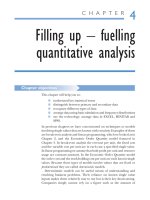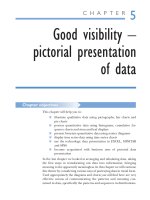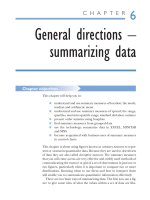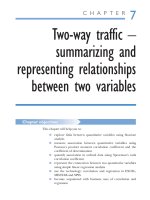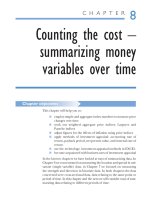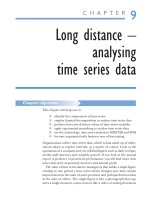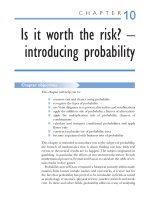Research methods for business 5th ch10
Bạn đang xem bản rút gọn của tài liệu. Xem và tải ngay bản đầy đủ của tài liệu tại đây (665.21 KB, 41 trang )
Slide 10.1
Chapter 10
Collecting primary data using semistructured, in-depth and group interviews
Saunders, Lewis and Thornhill, Research Methods for Business Students, 5th Edition, © Mark Saunders, Philip Lewis and Adrian Thornhill 2009
Slide 10.2
Saunders, Lewis and Thornhill, Research Methods for Business Students, 5th Edition, © Mark Saunders, Philip Lewis and Adrian Thornhill 2009
Slide 10.3
Research interviews
Definition
‘An interview is a purposeful discussion
between two or more people’
Kahn and Cannell (1957)
Types of interview used in research
Semi-structured
In-depth
Structured
Group
Saunders et al. (2009)
Saunders, Lewis and Thornhill, Research Methods for Business Students, 5th Edition, © Mark Saunders, Philip Lewis and Adrian Thornhill 2009
Slide 10.4
Saunders, Lewis and Thornhill, Research Methods for Business Students, 5th Edition, © Mark Saunders, Philip Lewis and Adrian Thornhill 2009
Slide 10.5
Research purpose and strategy (1)
Forms of interview
Figure 10.1 Forms of interview
Saunders et al. (2009)
Saunders, Lewis and Thornhill, Research Methods for Business Students, 5th Edition, © Mark Saunders, Philip Lewis and Adrian Thornhill 2009
Slide 10.6
Types of interview
• Structured interviews: use questionnaire based on a
predetermined and ‘standardized’ or identical set of
questions and we refer to them as interviewer
administered questionnaires.
• Semi-structure interviews: the researcher will have a list
of themes and questions to be covered, although these
may vary from interview to interview. This means that
you may omit some questions in particular interviews,
given a specific organizational context that is
encountered in relation to the research topic. The order
of questions also be varied depending on the flow of
conversation.
Saunders, Lewis and Thornhill, Research Methods for Business Students, 5th Edition, © Mark Saunders, Philip Lewis and Adrian Thornhill 2009
Slide 10.7
Continued
• On the other hand, additional questions may be required
to explore your research question and objectives given
the nature of events within particular organizations.
• Unstructured interviews: are informal. You would use
these to explore in-depth a general area in which you
are interested . We therefore, refer to these as in-depth
interviews. There is no predetermined list of questions
to work through in this situation, although you need to
have a clear idea about the aspect or aspects that you
want to explore. The interviewee is given the opportunity
to talk freely about events behavior and beliefs in
relation to topic area.
Saunders, Lewis and Thornhill, Research Methods for Business Students, 5th Edition, © Mark Saunders, Philip Lewis and Adrian Thornhill 2009
Slide 10.8
Continued
• So that this type of interaction is sometimes called
‘nondirective’. It has been labeled as informant interview
since it is the interviewees perceptions that guide the
conduct of the interview. In comparison, a participant (or
respondent) interview is one where the interviewer directs
the interview and the interviewee responds to the
questions of the researcher.
• We can also differentiate between types of interview
related to the nature of interaction between the researcher
and those who participate in this process. Interview may
be conducted one to one basis, between you and single
participant(face to face)(telephone)(internet) (intranet)
Saunders, Lewis and Thornhill, Research Methods for Business Students, 5th Edition, © Mark Saunders, Philip Lewis and Adrian Thornhill 2009
Slide 10.9
Continued
• There may be other situation where you
conduct a number of participants to explore
an aspect of your research through a group of
discussion that you facilitate.
Saunders, Lewis and Thornhill, Research Methods for Business Students, 5th Edition, © Mark Saunders, Philip Lewis and Adrian Thornhill 2009
Slide 10.10
Interview and type of research
• In an exploratory research study, in-depth interviews
can be very helpful to find out what is happening and to
seek new insight. Semi stretchered interviews may be
used in relation to an exploratory study.
• In descriptive studies structured interviews can be used
as a means to identify general patterns.
• In an explanatory study, semi structured interviews can
be used in order to understand the relationships
between variables, such as those revealed from a
descriptive study, structured interview may also be used
in relation to an explanatory study, in statistical sense.
Saunders, Lewis and Thornhill, Research Methods for Business Students, 5th Edition, © Mark Saunders, Philip Lewis and Adrian Thornhill 2009
Slide 10.11
Research purpose and strategy (2)
Uses of different types of interview in each of
the main research categories
Saunders et al. (2009)
Table 10.1 Uses of different types of interview in each of the main research
categories
Saunders, Lewis and Thornhill, Research Methods for Business Students, 5th Edition, © Mark Saunders, Philip Lewis and Adrian Thornhill 2009
Slide 10.12
Saunders, Lewis and Thornhill, Research Methods for Business Students, 5th Edition, © Mark Saunders, Philip Lewis and Adrian Thornhill 2009
Slide 10.13
Non-standardised (qualitative)
interviews
Four key aspects
• Purpose of the research
• Significance of establishing personal
contact
• Nature of the data collection questions
• Time required and completeness of process
Saunders, Lewis and Thornhill, Research Methods for Business Students, 5th Edition, © Mark Saunders, Philip Lewis and Adrian Thornhill 2009
Slide 10.14
Saunders, Lewis and Thornhill, Research Methods for Business Students, 5th Edition, © Mark Saunders, Philip Lewis and Adrian Thornhill 2009
Slide 10.15
Saunders, Lewis and Thornhill, Research Methods for Business Students, 5th Edition, © Mark Saunders, Philip Lewis and Adrian Thornhill 2009
Slide 10.16
Saunders, Lewis and Thornhill, Research Methods for Business Students, 5th Edition, © Mark Saunders, Philip Lewis and Adrian Thornhill 2009
Slide 10.17
Saunders, Lewis and Thornhill, Research Methods for Business Students, 5th Edition, © Mark Saunders, Philip Lewis and Adrian Thornhill 2009
Slide 10.18
Saunders, Lewis and Thornhill, Research Methods for Business Students, 5th Edition, © Mark Saunders, Philip Lewis and Adrian Thornhill 2009
Slide 10.19
Data quality (1)
Issues to consider
•
Reliability
•
Forms of bias
•
Validity and generalisability
Saunders, Lewis and Thornhill, Research Methods for Business Students, 5th Edition, © Mark Saunders, Philip Lewis and Adrian Thornhill 2009
Slide 10.20
Saunders, Lewis and Thornhill, Research Methods for Business Students, 5th Edition, © Mark Saunders, Philip Lewis and Adrian Thornhill 2009
Slide 10.21
Saunders, Lewis and Thornhill, Research Methods for Business Students, 5th Edition, © Mark Saunders, Philip Lewis and Adrian Thornhill 2009
Slide 10.22
Saunders, Lewis and Thornhill, Research Methods for Business Students, 5th Edition, © Mark Saunders, Philip Lewis and Adrian Thornhill 2009
Slide 10.23
Data quality (2)
The importance of preparation – the 5 Ps
‘prior planning prevents poor performance’
Saunders et al. (2009)
Saunders, Lewis and Thornhill, Research Methods for Business Students, 5th Edition, © Mark Saunders, Philip Lewis and Adrian Thornhill 2009
Slide 10.24
Saunders, Lewis and Thornhill, Research Methods for Business Students, 5th Edition, © Mark Saunders, Philip Lewis and Adrian Thornhill 2009
Slide 10.25
Saunders, Lewis and Thornhill, Research Methods for Business Students, 5th Edition, © Mark Saunders, Philip Lewis and Adrian Thornhill 2009



